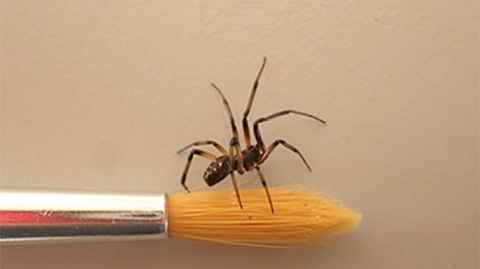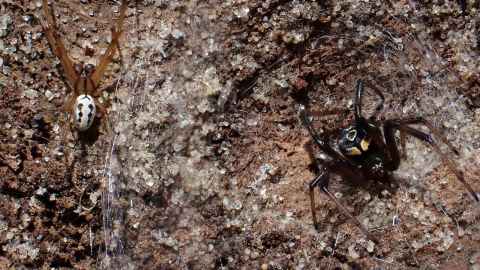Why did scientists stage a spider sports event?
31 October 2025
Yes, seriously. The aim was to assess the threat from an invasive species.

Master of Science student James Roberts put katipō spiders through their paces – a running track, a climbing pole, a maze – for comparisons with an invasive species.
The study was no joke, because the false katipō from South Africa is edging out the native spider, says Roberts.
The katipō, which lives in sand dunes, is Aotearoa New Zealand’s only native widow spider and is already in decline.
“If the false katipō has an edge, that could speed displacement and complicate dune conservation,” says Roberts.
Spiders were chased down a running track with a paintbrush to encourage movement.

“False katipō were more exploratory and completed the track faster; maze speed and climbing performance were similar,” says Roberts. “In simple terms, false katipō looked bolder, while katipō seemed more cautious.”
False katipō may be better equipped to spread into disturbed dunes, such as those affected by severe weather or four-wheel-drives.
He noted that the study was small and the results indicative only. The study participants were all male, because females tend to set up a web and not move, whereas males explore to find a female and mate.
“I’m hopeful the native katipō can be saved, as with many of our species, if we provide sustained conservation support,” he says. “Dune restoration would make a substantial difference.”
Should we worry about losing this venomous species?
“Katipō is an endemic, uniquely Aotearoa species with cultural significance," says Roberts. “The name kati-pō – night-stinger – is a rare example of a spider name in te reo Māori.”
It's a key invertebrate predator in dune food webs and losing it would further disrupt a native eco-system.
“Even if false katipō overlaps functionally, an introduced species is not a like-for-like replacement for an endemic species,” he says.
“False katipō could eat more native invertebrates, which may create an imbalance. In short, the loss of katipō would diminish both our biodiversity and our cultural heritage.”
The Shorebirds Trust, the Department of Conservation and Auckland Council enabled the research. The senior author of the research paper was University of Auckland Professor Dianne Brunton and the co-author was Dr Anne Wignall.
Why are they called ”widow” spiders? Females have occasionally been observed consuming males, though how often this happens is unknown.
Media contact
Paul Panckhurst | Science media adviser
M: 022 032 8475
E: paul.panckhurst@auckland.ac.nz